Abstract
Cat eye syndrome (CES) is typically associated with a supernumerary bisatellited marker chromosome (inv dup 22pter-22q11.2) resulting in four copies of this region. We describe an individual showing the inheritance of a minute supernumerary double ring chromosome 22, which resulted in expression of all cardinal features of CES. The size of the ring was determined by DNA dosage analysis and FISH analysis for five loci mapping to 22q11.2. The probes to the loci D22S9, D22S43, and ATP6E were present in four copies, whereas D22S57 and D22S181 were present in two copies. This finding further delineates the distal boundary of the critical region of CES, with ATP6E being the most distal duplicated locus identified. The phenotypically normal father and grandfather of the patient each had a small supernumerary ring chromosome and demonstrated three copies for the loci D22S9, D22S43, and ATP6E. Although three copies of this region have been reported in other cases with CES features, it is possible that the presence of four copies leads to greater susceptibility.
Full text
PDF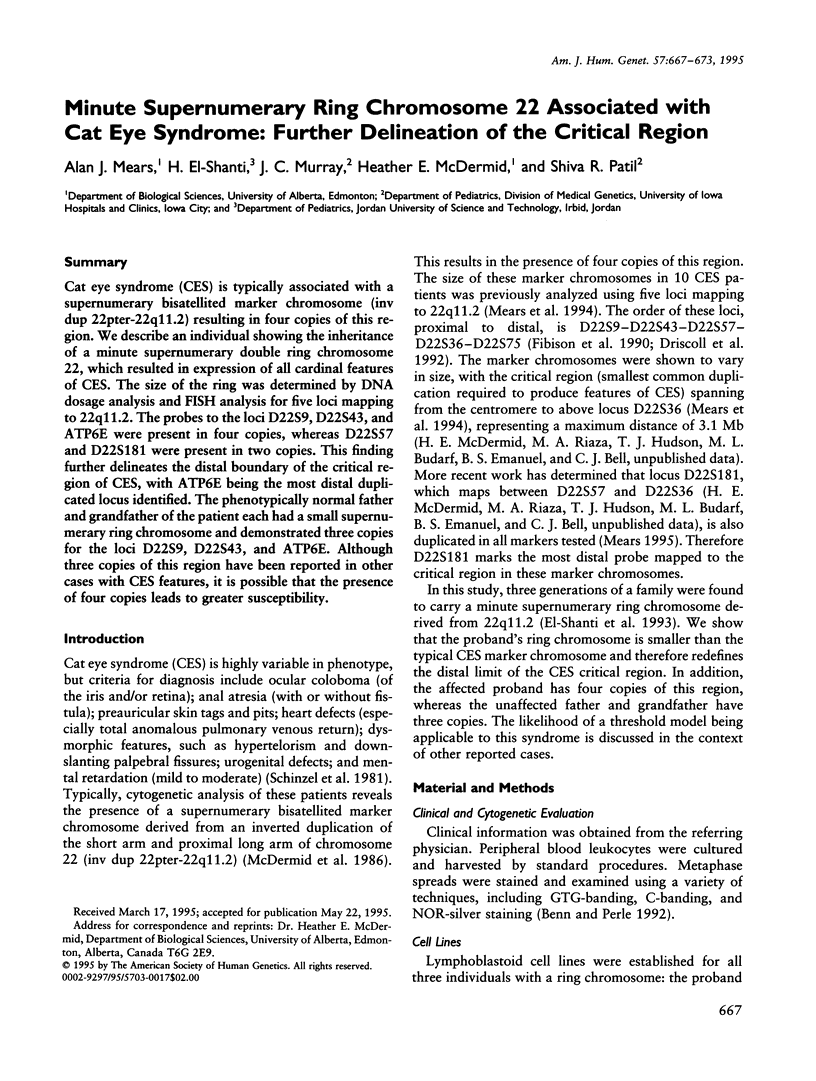
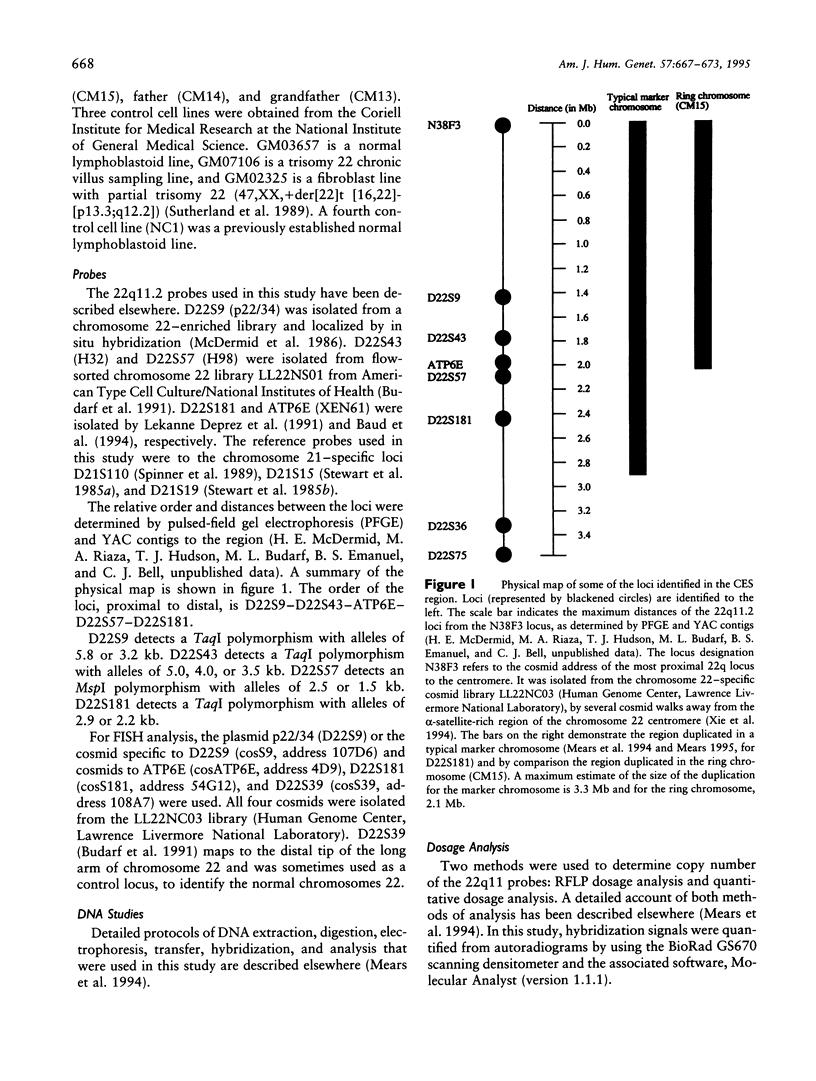
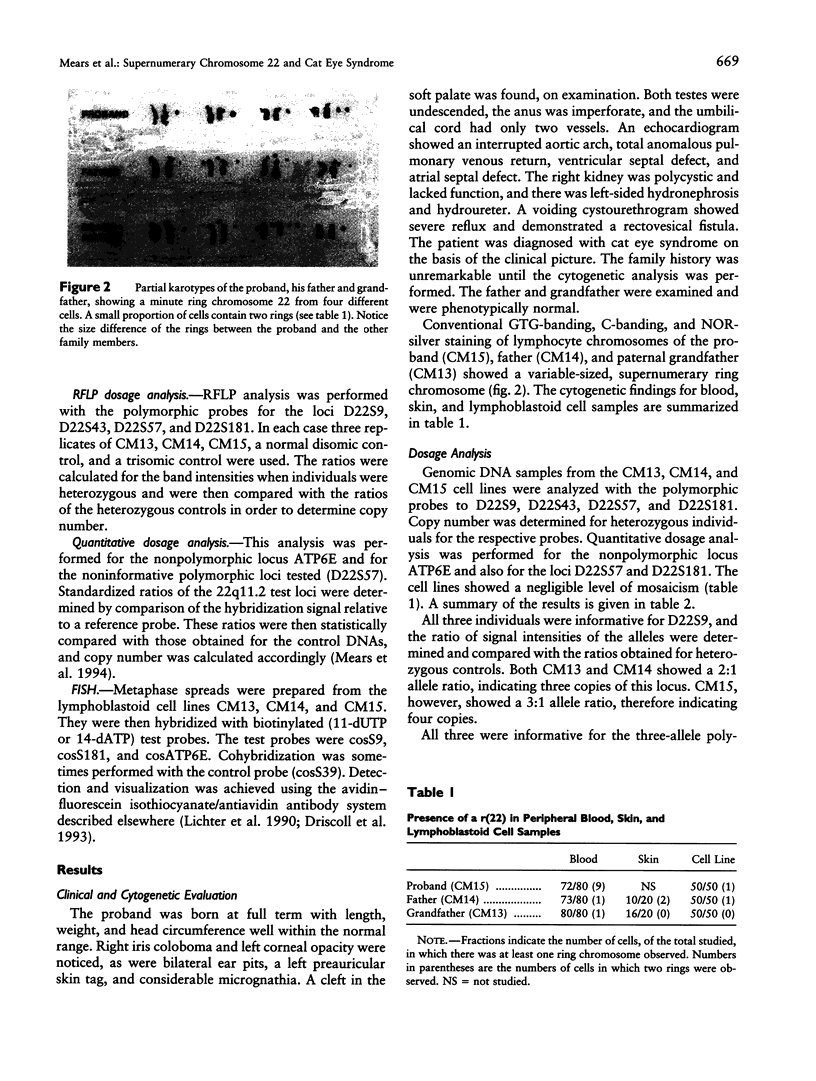
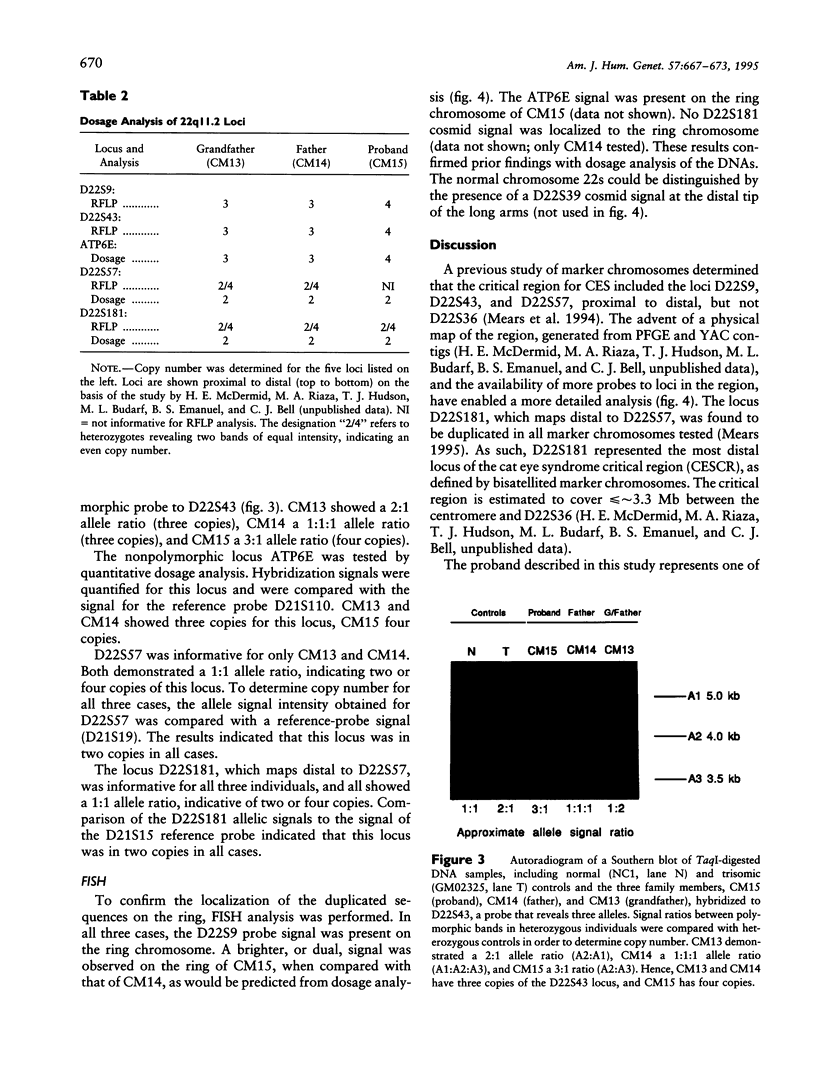
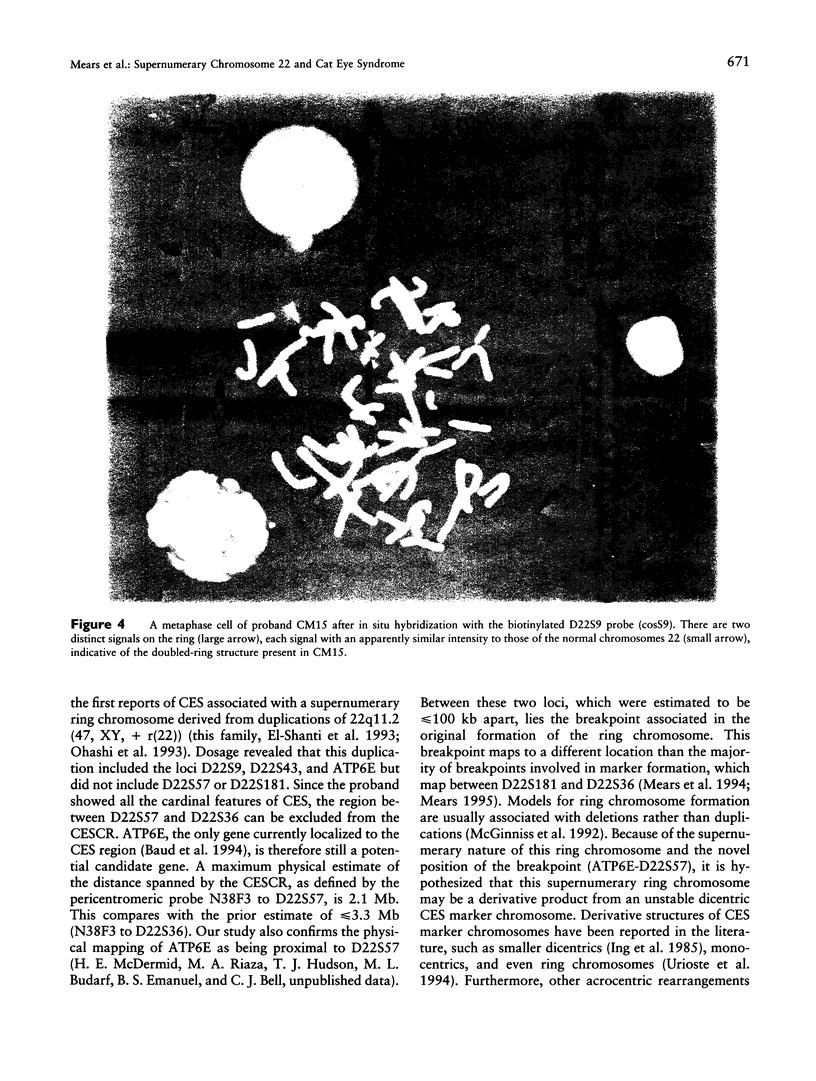
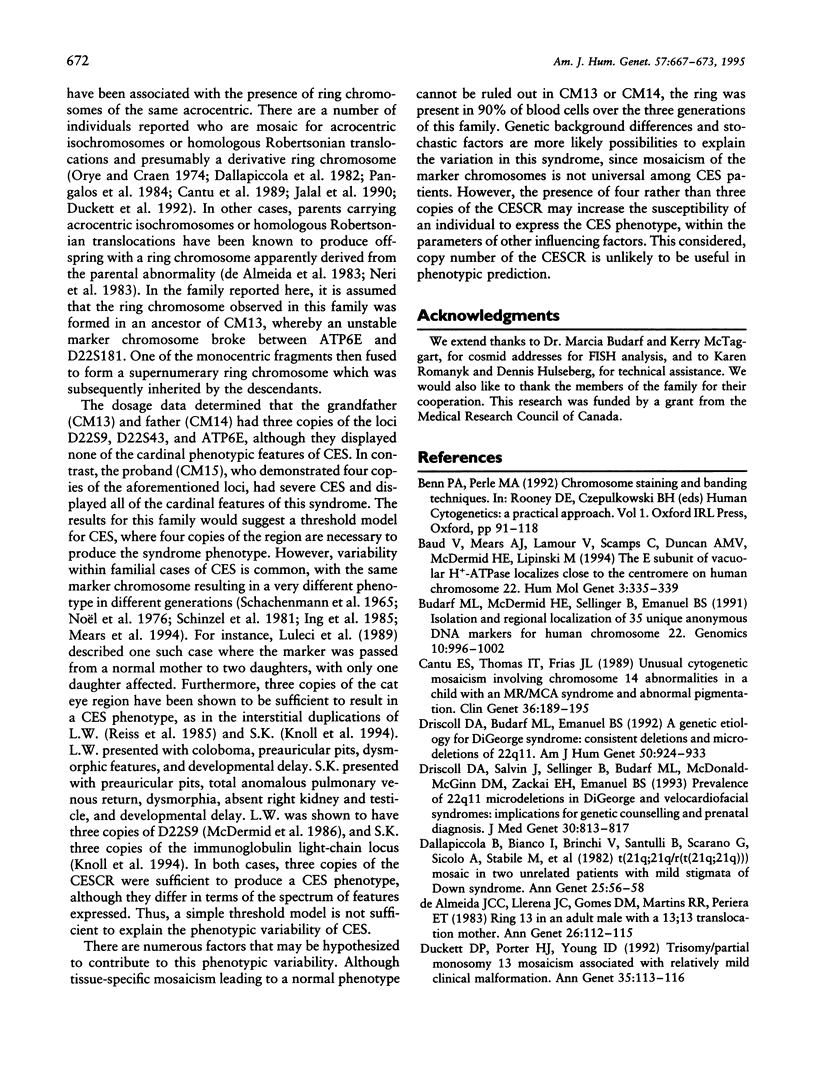
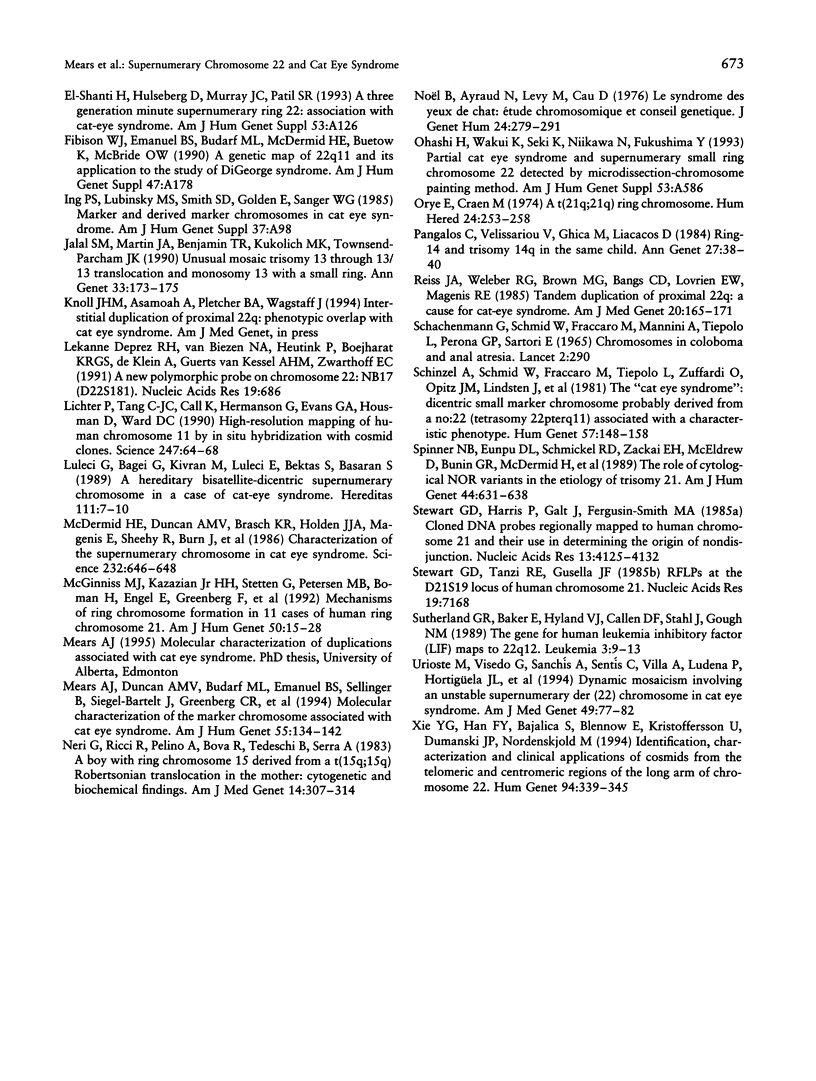
Images in this article
Selected References
These references are in PubMed. This may not be the complete list of references from this article.
- Baud V., Mears A. J., Lamour V., Scamps C., Duncan A. M., McDermid H. E., Lipinski M. The E subunit of vacuolar H(+)-ATPase localizes close to the centromere on human chromosome 22. Hum Mol Genet. 1994 Feb;3(2):335–339. doi: 10.1093/hmg/3.2.335. [DOI] [PubMed] [Google Scholar]
- Budarf M. L., McDermid H. E., Sellinger B., Emanuel B. S. Isolation and regional localization of 35 unique anonymous DNA markers for human chromosome 22. Genomics. 1991 Aug;10(4):996–1002. doi: 10.1016/0888-7543(91)90190-p. [DOI] [PubMed] [Google Scholar]
- Cantú E. S., Thomas I. T., Frias J. L. Unusual cytogenetic mosaicism involving chromosome 14 abnormalities in a child with an MR/MCA syndrome and abnormal pigmentation. Clin Genet. 1989 Sep;36(3):189–195. doi: 10.1111/j.1399-0004.1989.tb03187.x. [DOI] [PubMed] [Google Scholar]
- Dallapiccola B., Bianco I., Brinchi V., Santulli B., Scarano G., Sicolo A., Stabile M., Ventruto V. t(21q21q)/r[t(21q21q)] mosaic in two unrelated patients with mild stigmata of Down's syndrome. Ann Genet. 1982;25(1):56–58. [PubMed] [Google Scholar]
- Driscoll D. A., Budarf M. L., Emanuel B. S. A genetic etiology for DiGeorge syndrome: consistent deletions and microdeletions of 22q11. Am J Hum Genet. 1992 May;50(5):924–933. [PMC free article] [PubMed] [Google Scholar]
- Driscoll D. A., Salvin J., Sellinger B., Budarf M. L., McDonald-McGinn D. M., Zackai E. H., Emanuel B. S. Prevalence of 22q11 microdeletions in DiGeorge and velocardiofacial syndromes: implications for genetic counselling and prenatal diagnosis. J Med Genet. 1993 Oct;30(10):813–817. doi: 10.1136/jmg.30.10.813. [DOI] [PMC free article] [PubMed] [Google Scholar]
- Duckett D. P., Porter H. J., Young I. D. Trisomy/partial monosomy 13 mosaicism associated with relatively mild clinical malformation. Ann Genet. 1992;35(2):113–116. [PubMed] [Google Scholar]
- Jalal S. M., Martin J. A., Benjamin T. R., Kukolich M. K., Townsend-Parcham J. K. Unusual mosaic trisomy 13 through 13/13 translocation and monosomy 13 with a small ring. Ann Genet. 1990;33(3):173–175. [PubMed] [Google Scholar]
- Lekanne Deprez R. H., van Biezen N. A., Heutink P., Boejharat K. R., de Klein A., Geurts van Kessel A. H., Zwarthoff E. C. A new polymorphic probe on chromosome 22: NB17 (D22S181). Nucleic Acids Res. 1991 Feb 11;19(3):686–686. [PMC free article] [PubMed] [Google Scholar]
- Lüleci G., Bağci G., Kivran M., Lüleci E., Bektaş S., Başaran S. A hereditary bisatellite-dicentric supernumerary chromosome in a case of cat-eye syndrome. Hereditas. 1989;111(1):7–10. doi: 10.1111/j.1601-5223.1989.tb00369.x. [DOI] [PubMed] [Google Scholar]
- McDermid H. E., Duncan A. M., Brasch K. R., Holden J. J., Magenis E., Sheehy R., Burn J., Kardon N., Noel B., Schinzel A. Characterization of the supernumerary chromosome in cat eye syndrome. Science. 1986 May 2;232(4750):646–648. doi: 10.1126/science.3961499. [DOI] [PubMed] [Google Scholar]
- McGinniss M. J., Kazazian H. H., Jr, Stetten G., Petersen M. B., Boman H., Engel E., Greenberg F., Hertz J. M., Johnson A., Laca Z. Mechanisms of ring chromosome formation in 11 cases of human ring chromosome 21. Am J Hum Genet. 1992 Jan;50(1):15–28. [PMC free article] [PubMed] [Google Scholar]
- Mears A. J., Duncan A. M., Budarf M. L., Emanuel B. S., Sellinger B., Siegel-Bartelt J., Greenberg C. R., McDermid H. E. Molecular characterization of the marker chromosome associated with cat eye syndrome. Am J Hum Genet. 1994 Jul;55(1):134–142. [PMC free article] [PubMed] [Google Scholar]
- Neri G., Ricci R., Pelino A., Bova R., Tedeschi B., Serra A. A boy with ring chromosome 15 derived from a t(15q;15q) Robertsonian translocation in the mother: cytogenetic and biochemical findings. Am J Med Genet. 1983 Feb;14(2):307–314. doi: 10.1002/ajmg.1320140211. [DOI] [PubMed] [Google Scholar]
- Noël B., Ayraud N., Levy M., Cau D. Le syndrome des yeux de chat. Etude chromosomique et conseil génétique. J Genet Hum. 1976 Nov;24 (Suppl):279–291. [PubMed] [Google Scholar]
- Orye E., Craen M. A t(21q21q) ring chromosome. Hum Hered. 1974;24(3):253–258. doi: 10.1159/000152658. [DOI] [PubMed] [Google Scholar]
- Pangalos C., Velissariou V., Ghica M., Liacacos D. Ring-14 and trisomy 14q in the same child. Ann Genet. 1984;27(1):38–40. [PubMed] [Google Scholar]
- Reiss J. A., Weleber R. G., Brown M. G., Bangs C. D., Lovrien E. W., Magenis R. E. Tandem duplication of proximal 22q: a cause of cat-eye syndrome. Am J Med Genet. 1985 Jan;20(1):165–171. doi: 10.1002/ajmg.1320200120. [DOI] [PubMed] [Google Scholar]
- SCHACHENMANN G., SCHMID W., FRACCARO M., MANNINI A., TIEPOLO L., PERONA G. P., SARTORI E. CHROMOSOMES IN COLOBOMA AND ANAL ATRESIA. Lancet. 1965 Aug 7;2(7406):290–290. doi: 10.1016/s0140-6736(65)92415-3. [DOI] [PubMed] [Google Scholar]
- Schinzel A., Schmid W., Fraccaro M., Tiepolo L., Zuffardi O., Opitz J. M., Lindsten J., Zetterqvist P., Enell H., Baccichetti C. The "cat eye syndrome": dicentric small marker chromosome probably derived from a no.22 (tetrasomy 22pter to q11) associated with a characteristic phenotype. Report of 11 patients and delineation of the clinical picture. Hum Genet. 1981;57(2):148–158. doi: 10.1007/BF00282012. [DOI] [PubMed] [Google Scholar]
- Spinner N. B., Eunpu D. L., Schmickel R. D., Zackai E. H., McEldrew D., Bunin G. R., McDermid H., Emanuel B. S. The role of cytologic NOR variants in the etiology of trisomy 21. Am J Hum Genet. 1989 May;44(5):631–638. [PMC free article] [PubMed] [Google Scholar]
- Stewart G. D., Harris P., Galt J., Ferguson-Smith M. A. Cloned DNA probes regionally mapped to human chromosome 21 and their use in determining the origin of nondisjunction. Nucleic Acids Res. 1985 Jun 11;13(11):4125–4132. doi: 10.1093/nar/13.11.4125. [DOI] [PMC free article] [PubMed] [Google Scholar]
- Stewart G. D., Tanzi R. E., Gusella J. F. RFLPS at the D21S19 locus of human chromosome 21. Nucleic Acids Res. 1985 Oct 11;13(19):7168–7168. doi: 10.1093/nar/13.19.7168. [DOI] [PMC free article] [PubMed] [Google Scholar]
- Sutherland G. R., Baker E., Hyland V. J., Callen D. F., Stahl J., Gough N. M. The gene for human leukemia inhibitory factor (LIF) maps to 22q12. Leukemia. 1989 Jan;3(1):9–13. [PubMed] [Google Scholar]
- Urioste M., Visedo G., Sanchís A., Sentís C., Villa A., Ludeña P., Hortigüela J. L., Martínez-Frías M. L., Fernández-Piqueras J. Dynamic mosaicism involving an unstable supernumerary der(22) chromosome in cat eye syndrome. Am J Med Genet. 1994 Jan 1;49(1):77–82. doi: 10.1002/ajmg.1320490114. [DOI] [PubMed] [Google Scholar]
- Xie Y. G., Han F. Y., Bajalica S., Blennow E., Kristoffersson U., Dumanski J. P., Nordenskjöld M. Identification, characterisation and clinical applications of cosmids from the telomeric and centromeric regions of the long arm of chromosome 22. Hum Genet. 1994 Oct;94(4):339–345. doi: 10.1007/BF00201589. [DOI] [PubMed] [Google Scholar]
- de Almeida J. C., Llerena J. C., Jr, Gomes D. M., Martins R. R., Pereira E. T. Ring 13 in an adult male with a 13:13 translocation mother. Ann Genet. 1983;26(2):112–115. [PubMed] [Google Scholar]





